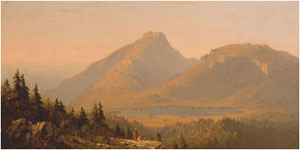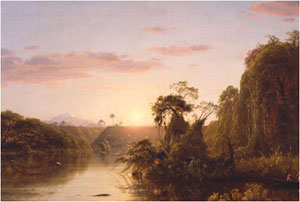It's not often works of art are implicated by both World Wars, but these paintings present a conflict between successors of claimants from the First World War and claimants from the Second World War.
The Ninth Circuit Court of Appeals yesterday heard an appeal over these 500-year-old works of art seized by the Bolsheviks and the Nazis,
Saher v. Norton Simon Art Museum, 07-5669. Pictured here are
Adam and
Eve by Lucas Cranach the Elder, 1520. The claimant, Marei Von Saher is the successor in interest to Jacques Goudstikker who bought the works in a 1931 auction in Berlin. The works remained there in Amsterdam until 1940 when the Nazis instituted a forced sale.
After the war, Desiree Goudstikker reached a settlement with the Dutch government. She received some of her husband's inventory, but did not claim another set of works because that would have ment returning the purchase price received from the Germans.
The Dutch government transferred those works to George Stroganoff-Scherbatoff, the heir of a noble Russian family who was thought to have lost the paintings to the Bolsheviks during the Russian Revolution.
The issue here is the timeliness of the action, which may have implications for other claimants -- including antiquities. Kenneth Ofgang, Staff Writer for
Metropolitan New-Enterprise has more:
"This has nothing to do with foreign policy,” Kaye told the judges. U.S. District Judge John Walter of the Central District of California had ruled that Code of Civil Procedure Sec. 354.3 is preempted because it conflicts with federal primacy in foreign affairs. Fred A. Rowley Jr. of Munger, Tolles and Olson, representing Pasadena’s Norton Simon Art Museum and its supporting foundation said the district judge was correct and the dismissal of Marei Von Saher’s action should be affirmed. Von Saher, a Connecticut resident, sued last year following the collapse of mediation over her claim that she and her family have lawful title to Adam and Eve, a diptych painted by famed German artist Lucas Cranach the Elder in the 16th Century.Von Saher’s late husband, Eduard “Edo” Von Saher, was the son of Jacques Goudstikker, a Dutch Jew who was one of Europe’s leading art dealers in the years leading up to World War II. Goudstikker fled Holland when the Nazis invaded in 1940, but was killed in an accidental fall aboard ship. His widow, Desiree Goudstikker, and their son eventually came to the United States and became citizens, having left behind their gallery; hundreds of art works, many of them by famous painters; and valuable real estate. Young Edo Goodstikker became Edo Von Saher after his mother remarried. The parties agree that Jacques Goudstikker purchased the wood panels at an auction in Berlin in the 1930s. But while Von Saher claims that her father-in-law acquired good title from the Soviet government, the foundation charges that he knew that Cranach’s work had been wrongfully expropriated from the wealthy and powerful Stroganoff family after it fled the Russian Revolution. The museum and foundation say museum benefactor Norton Simon lawfully acquired the panels for $800,000 from Commander George Stroganoff-Scherbatoff, who renounced his hereditary title, became a U.S. citizen, and served in the Navy during World War II.
The primary issue is whether California's special limitations rule for works looted during the Holocauset era, Sec. 354.3 conflicts with an Executive Order issued by President Truman.
See
here for more on Jacques Goudstikker.











